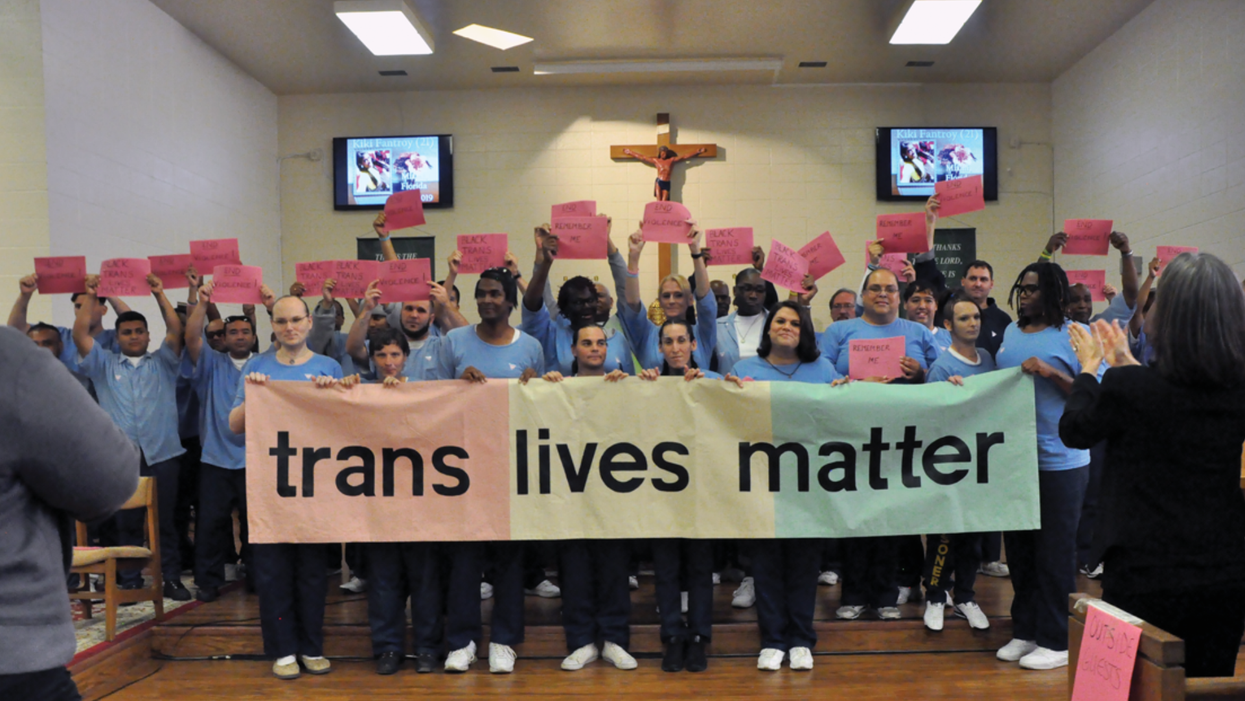Transgender Prison Inmates Face Troubling Issues Of Sexuality And Danger

Transgender Remembrance Day at San Quentin State Prison
The issue of where corrections officials will house transgender women isn’t going to go away soon. The March 16 temporary reauthorization of the Violence Against Women Act mentioned where transgender inmates should live. Sen. Tom Cotton (R-AR) introduced a bill to house inmates based on their genitals alone. There’s a bill on Washington Gov. Jay Inslee’s desk to prevent the press from accessing transgender inmates’ files.
So far, analysis of polices placing transgender women in women’s prisons has focused on safety. The Women’s Liberation Front (WoLF) filed suit to challenge California’s SB 132, a law that allows any male prisoner to identify as transgender and get moved to a women’s facility, vowing to fight for incarcerated women “until their safety and dignity are restored.”
Under the heading “Reaffirming the need for the elimination of violence against women,” Article 8 of the Women's Declaration International’s (formerly the Women’s Human Rights Campaign) Declaration on Women’s Sex-Based Rights wants transgender women out of women’s spaces because “single-sex services and physical spaces …provide them with safety, privacy, and dignity.” The message is clear: when trans women are around, there’s no safety.
Casting the conversations around housing transgender inmates in terms of safety is a mistake. It’s better to analyze these policies’ effects on rehabilitation which, after all, is supposed to be the mission of corrections.
Saying transgender women pose a safety threat when housed with other women was a bad move because it implies that transgender people are inherently dangerous when they’re not. And that unfair characterization of transgender women has more far-reaching effects. In essence, it has shut down and sidestepped substantive discussions of these policies lest participants get labeled transphobic.
I disagree that it’s transphobic to analyze whether these policies benefit inmates. The addition of transgender women to traditionally female facilities might not culminate in rape. Instead, the result might be recidivism and we need to decide if we can accept that effect.
People in prison develop relationships that can be sexual, romantic, business-related, or friendly. It’s impossible to cram thousands of people into one small space and prohibit connections between them. Not all of these relationships are illicit or illegal.
But many are. Sex will be had and whether it’s consensual or not depends on the unique circumstances of each situation and the laws in the state. While sexual contact between a prisoner and a staff member is always non-consenual under the Prison Rape Elimination Act, some states criminalize sexual contact between inmates. California criminalizes only sodomy between inmates. That’s an important distinction because much of the safety rhetoric surrounding the housing of transgender inmates depends on sexual activity between inmates being statutory sexual assault. It’s possible for two inmates in California to have sex with each other without committing rape.
And that’s the problem that, so far, remains unspoken: consensual sex in prisons is just as much of a problem as sexual violence. Consensual sex is still against the rules in all 50 states and subjects people to discipline. I’m highly critical of prison disciplinary systems, especially the enforcement of rules, but this one I support and my position has nothing to do with gender or sexuality. Rather, it has everything to do with my desire to see these women succeed.
Introducing a new population of prisoners, women who have male genitalia, adds a new — and quite frankly, for some, exciting — dimension to a prison subculture. Undoubtedly some women will seek sexual connection with an inmate with male genitalia; the California Department of Corrections and Rehabilitation bet on it when they started distributing condoms shortly after implementing a law that places transgender women in women’s prisons.
Women in prison who embrace that subculture are “less inclined to introspection and continue to involve themselves in relationships, drugs, and other distractions to divert their attention away from looking at their own behavior,” according to researchers who’ve examined relationships in prison.
If a person’s life has become so out of control that they’re incarcerated, then they need to focus all of their energy on taking that control back. Investing energy in romantic or sexual connections diverts attention away from that goal. This is standard advice for anyone in recovery from substance abuse. Even if a prisoner is innocent or her confinement owes itself to purely structural factors, that person still needs to learn how to navigate those unjust systems to protect herself. A ‘bae’ or a ‘boo’ makes those lessons much harder.
Inmates admit that these aren’t really prosocial connections. In a survey of women incarcerated at the federal prison in Alderson, West Virginia, the most reported motivation attributed to prison sexual/romantic relationships is that they’re economic in nature. It’s essentially prostitution where the currency is ramen soup.
Watching women throw away opportunities to see their children in the visiting room or even their chances at parole was a constant for me while I was incarcerated. They’d develop a discipline history for behaviors related to seeing their girlfriends, activities that had nothing to do with sex, like being out of place or carrying benign contraband, and lose visiting privileges and their chances to sit before parole boards.
The system views women who do this much like the quote from Benjamin Franklin that said “Those who would give up essential Liberty, to purchase a little temporary Safety, deserve neither Liberty nor Safety” — which, incidentally, doesn’t mean what most people assume it means. But the sentiment tracks to modern corrections; parole board members think that, if women are willing to endanger their liberty for fleeting romantic or sexual connections that may not be real, then they shouldn’t get either. Denied.
We have to grapple with whether effects on rehabilitation are acceptable byproducts of housing transgender prisoners by their gender identity. Incarcerated women should know better than to endanger reuniting with their families for a fling, but their decision-making skills can be suspect at times, hence their current predicament. I don’t think it’s fair to tempt them.
Of course, just because inmates are capable of consensual sex with each other doesn’t make sexual assault impossible. In Illinois, a cisgender female prisoner accused a transgender prisoner of sexual assault. The Department of Correction dismissed the complainant’s report, saying that the sexual contact was consensual; she’s now suing the state for being disbelieved. It bears noting that, in this situation, in a time when believing women has become paramount, authorities believed the woman with the penis.
But transgender inmates face sexual violence and harassment at rates 10 times higher than cisgender inmates when prisons house them according to their natal genitalia. Not only is it unconstitutional to confine people and not protect them from sexual harm but it’s also morally untenable to know that people face a risk of that type of violence and not stop it.
We may be forced to accept that transgender inmates’ rights to security will cost other inmates their liberty, long-term, because of compromised opportunities for rehabilitation. The question becomes more about why as a country we rely on a system that won’t protect both liberty and security, and less about where we should house transgender inmates.
Chandra Bozelko did time in a maximum-security facility in Connecticut. While inside she became the first incarcerated person with a regular byline in a publication outside of the facility. Her “Prison Diaries" column ran in The New Haven Independent, and she later established a blog under the same name that earned several professional awards. Her columns now appear regularly in The National Memo.
- Transgender Inmates | The Marshall Project ›
- Transgender Inmates in Prisons ›
- Transgender Prisoners Say They 'Never Feel Safe.' Could a ... ›
- Female inmates sue over California transgender prison law | The ... ›
- California prisons consider gender-identity housing requests - Los ... ›
- Justice Department reviewing policies on transgender inmates ›
- Police, Jails & Prisons | National Center for Transgender Equality ›








